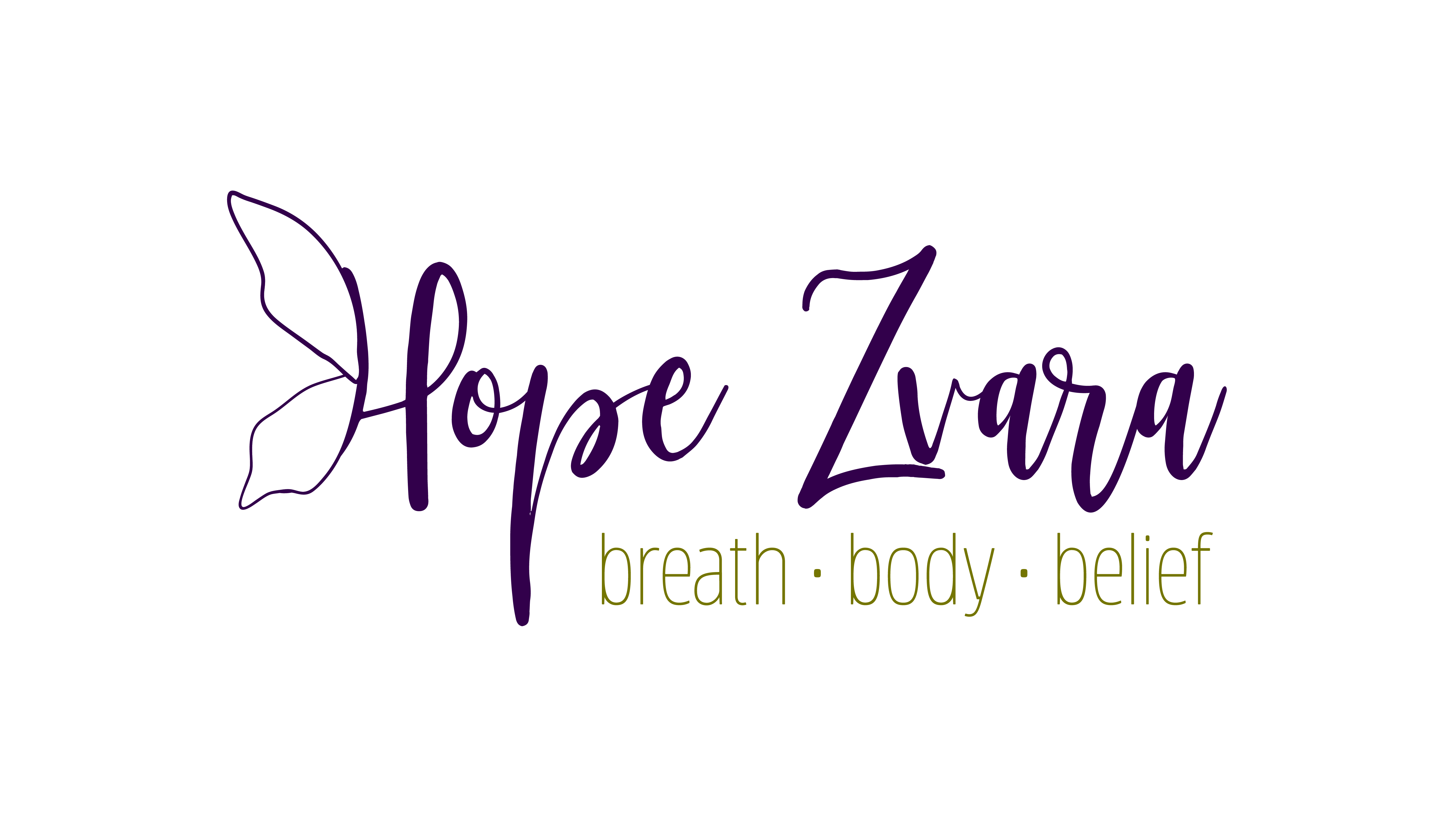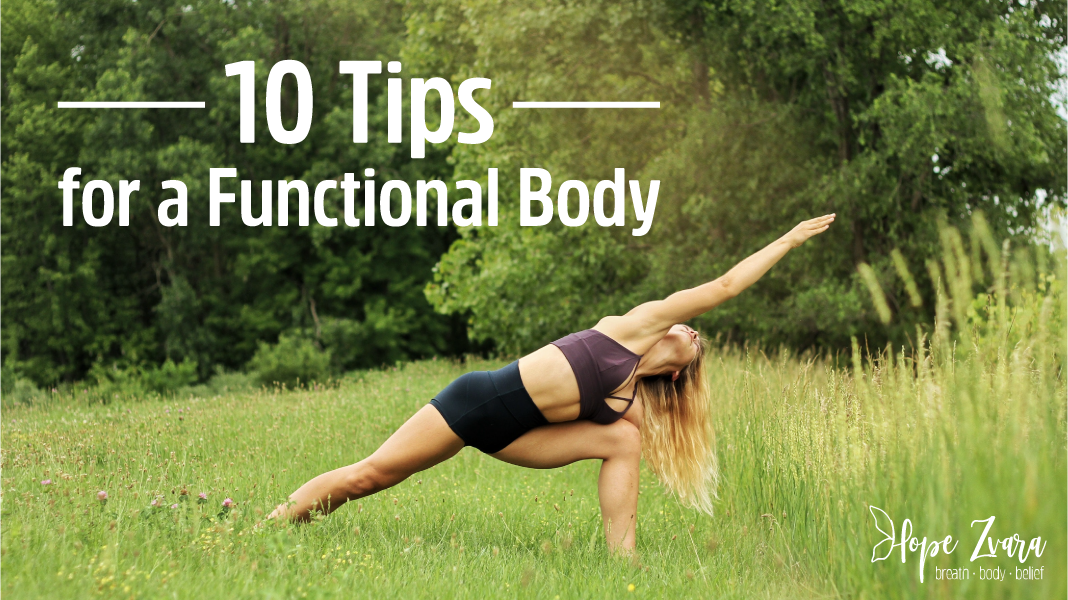
by Hope Zvara | Oct 25, 2019 | Fitness Friday, Lifestyle
Most people come to fitness training and movement, such as yoga, in order to benefit their bodies and their lives. Yet, many are unknowingly practicing movements that are inefficient or even detrimental to their goals and health. There are certain tips that can help you achieve the functional body that will serve you in your everyday life.
Here are 10 Key Tips to Stop Treating Pain and to Start Treating Dysfunction for a Functional Body:
1. Get off the Floor.
Unless you are a mechanic, training yourself, especially your core, solely on the floor will not get you the results you are hoping to achieve. Think about what you are trying to do on the floor. Lying flat on your back to do core work only triggers about 10% of your transversus abdominus, your core-most muscle (which is also a back muscle). So how about standing “Pilates” or what about the standing “Saw”? Look at what the movement is trying to achieve, not necessarily what it looks like, so you can morph it into a more body-friendly version.
If you are serious about strengthening your core, check out the Core Functional Fitness program to take your core to another level.
2. Shed the Shoes.
Shoes can isolate a person’s feet and keep them from noticing signs of misalignment, such as pronation, supination or bunions. Treadwear on the soles of the shoes can reveal dysfunction, as well. Overly supportive shoes compensate for and cover up dysfunction, but do not heal it. Training in such shoes might work around the issues, instead of bringing them to light. If you suffer from foot pain, know that pain relief is not far.
3. Learn Neutral.
It’s important to understand that a neutral position is not natural for many people. Proper body placement often must be re-learned with the guidance of someone trained in alignment. Proper neutral alignment involves attention to the relationship between the feet, pelvis, rib cage, shoulders and head.
4. Do Exercises and Asanas that Expose Imbalances.
Finding what is imbalanced is necessary for enabling proper alignment and movement. Identify where movement becomes stuck and focus on un-sticking that area.
5. Use a 2:1 Ratio.
By working both sides equally, the weaker side will never catch up. Instead, double up on the weaker side, so it receives the extra strengthening it needs.
Movement in every direction is the only way to address the different needs of the body. Practice poses that move along the sagittal plane (left and right), the frontal plane (front and back) and the transverse plane (above and below).
7. Look at What a Movement is Trying to Accomplish.
Ask, “What is the purpose of this asana or exercise, and is it right for my body?” If not, determine how the concept could be adjusted for your individual body type. If you need help analyzing the movements, I have an Asana Video Library that will walk you through every specific element of each pose.
8. Identify the Source of the Pain.
Pain may not originate where it is felt. Sciatica, knee, neck or other pain may be referred — that is, their source is located somewhere other than where it hurts. Notice what is limited and what might be overused.
9. Learn Motor Control.
Between postures, be patient and aware. Is there a smooth, graceful transition from one posture to the next? Control begins by shifting awareness to the present and noticing the fine details that happen during the transition.
10. Think About the Reason for Practicing.
This is not to create doubt, but to check in and see if body, mind, spirit, and life are benefiting. Whatever you do should help you to increase wholeness and wellness.
Keep these tips in mind as you practice yoga, or any exercise to keep a functional body. If you are looking for a starting point, my Mindful Movement Online Studio costs only $9.99/month for unlimited access to my entire video library.
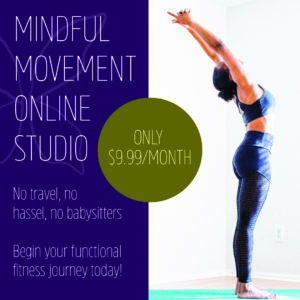
This post was originally published in the 2012 Edition of Natural Awakenings Milwaukee.

by hope | Oct 11, 2019 | Fitness Friday, Working With Hope
Repetitive wrist strain is one of the most common injuries the average American suffers. There is an astounding amount of people leading sedentary jobs. On top of that, we are living a life full of texting, Facebook and computers. There is little time of wrist relief for those poor little wrists of ours.
Fitness does not have to be formal. To be called yoga, it doesn’t even have to be practiced on a yoga mat. Three simple yet effective moves can help with writer’s cramp, carpal tunnel (which is simply inflammation in the carpal tunnel) and forearm strain. Let’s work to take a minibreak whenever we can to best help an area in which many have discomfort yet few do something about.
1. Wrist Extension
In a comfortable seated or standing position, extend your left arm directly out in front of the shoulder. Flex the hand to turn the fingers to the sky, palm facing out. Using the other hand, draw back on the extended arm’s fingers, thumb and top of the palm. Give a gentle pull as you reach out through the heel of the hand. You should feel this in your forearm. Imagine a rod extending out from the heel of the hand as you flex the palm back. Be mindful to keep the arm straight (no hyperextension in the elbow) and the shoulder relaxed.
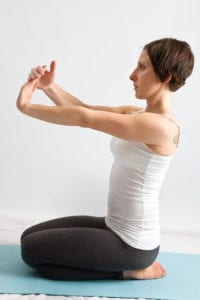
Hold this simple yet intense stretch for five to ten slow mindful breaths, noticing the stretch in the palm as well as the forearm.
2. Wrist Flexion
Next, turn the fingers to face downward from the same extended position. Now using the opposite hand, draw back on the top of the palm (not just the fingers) and extend out through the top of the wrist. Check to keep the length through the arm. Allow the fold of the elbow to rotate upward as you relax the shoulder.
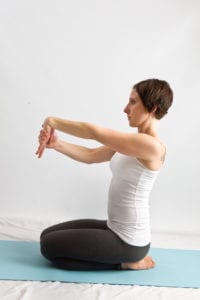
Hold this stretch for five to ten breaths, noticing the stretch in the top of the wrist into the forearm.
3. Wrist Twist
Finally, take the same hand and place the palm to the center of the chest, fingers toward the sky. Using the opposite hand, clasp hold of the thumb side of the hand. Wrap your fingers into the center of the planted palm. Breathing calmly, start to guide the hand into a twisted position at the wrist line. As you twist the wrist, try to resist the twist, working to draw back against the twist feeling. You should feel a deep opening along the wrist and forearm. Be mindful to keep the wrist and hand upright to keep the twist balanced and deep.

Remain holding the twist for five to ten breaths. As you release, allow the hand to rest, then work it into an opening and closing movement until you feel balance once again.
These stretches are incredibly helpful for those of us who use computers on a regular basis. Many of our communities are now seeing repetitive wrist strain much earlier in life than ever before. Try to incorporate these three simple stretches into your day at any moment. Not only will they give wrist relief to the tech geek, they will also aid in some much-needed wrist rehab for those of you who suffer from Plank Pose complaints or tender wrists in any pose that puts pressure on the palms.
As you step back into your everyday lives, remember one important thing: Nothing works unless you actually do it. I hope you get some wrist relief – Good luck!
This article was featured in the April 2013 edition of Nature’s Pathway’s Magazine Southeast Wisconsin Edition.

by hope | Sep 20, 2019 | Core Functional Fitness, Fitness Friday
Almost every yoga class features at least one plank, yet very few can honestly say that they know completely what’s going on in Plankasana. Most view it as a great core asana, yet few actually access their true core. Many are cheating themselves or hurting their backs by allowing their arms to do all the work. You may not even realize you are doing plank WRONG!
To help you take full advantage of Plankasana, here’s an overview of this widely used, but often misunderstood asana. These lessons are adapted from a blog post I wrote for MindBodyGreen. For a limited time, I am offering my Master Plank course (6 weeks full of core-engaging content) for FREE! Sign Up today to get access to the course and get your plank in shape.
1. Pick your variation.
Will you be practicing on your hands or on your forearms? If you’re going to be practicing on your palms, set up your hands shoulder-distance apart and align the wrists under the shoulders. With your middle fingers pointing forward, press your entire hand into the floor, keeping a bit more weight in the knuckles.
From the shoulder, rotate the folds of the elbows forward, without hyperextending the joint (they look like they’re bending in the wrong direction). This is important so that you’re able to shift the load down into the core and prevent the shoulders from doing all the work. Without hunching, slide the shoulder blades down your back.
If you prefer planking on your forearms, get out of the habit of clasping the hands together in a triangle shape. This puts an emphasis on the pectorals, rather than the core. By opening up the arms to shoulder width, you shift the load to where it belongs. Turn the palms inward or upward when practicing, rather than down into the floor. Shift the weight evenly throughout the entire forearm and you’ll notice a significant increase in core power. Use a block between the palms for more core strength!
2. Get your legs in gear.
Your inner thighs are your pelvic floor’s favorite neighbor (way more than your butt). Bring your feet together so that they touch and engage your thighs inward toward each other. Then, press the quadriceps upward without hiking your buttocks. If you pay close enough attention, you should notice some activation in your pelvic floor area. By placing a foam yoga block or mini ball between the lower part of the thigh, you can generate more action in this area.
3. Resist gravity with the core.
Align your pelvis in neutral position (ASIS and pubis bone make a triangle shape that runs parallel to the floor), and resist gravity. By resisting gravity, you’re turning on your transversus abdominis, the hoop-like muscle at the deepest layer of the core. This is where the stability of plank begins.
Think of plank in thirds: 1/3 arms, 1/3 legs, 1/3 core. When you break down plank this way, you can focus on each section of the body and create better stability. Once you’ve successfully positioned yourself, check to make sure your head isn’t sagging (it puts more pressure on your wrists). Create length from your heels pressing back (not touching the floor) and your crown stretching forward.
Grab a partner and ask your partner to take her first two fingers and open them up like an upside-down V. Take that V and place a finger on each side of the lower spine. As she presses down on your lower back, resist her without pushing your buttocks upward or sagging down towards the floor. What you should feel is a quiver. This is the transversus abdominis earthquake.
4. Hold Your Plank.
Remain in Plankasana for up to 10 breaths, limiting belly breathing and maximizing side body breathing.
In Plank there should be zero back pain and no hip flexor pain. This can take time to perfect, especially if you’ve used everything but your core to do the core’s job throughout your entire life.
If your shoulder blades look like wings on an airplane, press into your palms and work to lift the rib cage up away from the floor. You’ll benefit greatly from the scapula push-up.
If you’re the opposite and you overly round your upper back (still avoiding your core), you’re probably overexerting your arm and chest muscles. Try sinking your chest a bit. As a teacher, I often rub my hand on the upper back to help smooth out this area.
The next time you practice plank, take a few extra moments to explain it thoroughly to your students or run through the tweaks yourself. Your core will thank you later. If you want more help with MASTERING your plank, join me in my six-week Master Plank course, FREE for a limited time.

If you are looking to strengthen your TRUE core for core stability, mobility, and functionality, consider the Three-Week Core Functional Fitness Course. My Core Functional Fitness Training approaches your core from all planes of motion – the way our bodies REALLY move – to reduce pain and injury, improve function, and deliver REAL power to your core – 408% more power!

Happy Planking!

